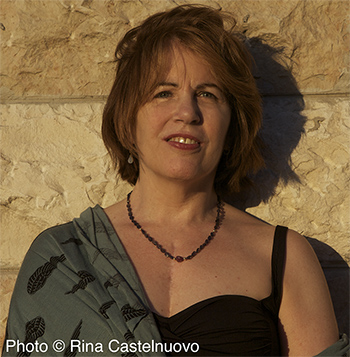
Rita Gabis
It wasn’t until she wrote her book A Guest at the Shooter’s Banquet, available now, that Rita Gabis learned the truth about her family’s complicated past.
Gabis is Lithuanian Catholic on her mother’s side and Eastern European Jewish on her father’s side. Her Jewish grandmother had left Ukraine after pogroms in the early 1900s and ended up in the Philadelphia in the 1920s, while her Lithuanian grandparents had each survived the Russian occupation and oppression of Lithuania before World War II and immigrated to New Jersey after the war.
The two sides of her family did not intermingle very often, however, and over the years Gabis noticed signs of deeper conflict within her family’s past. Though she always knew her Lithuanian grandfather as a joyful, gregarious man, who was hailed as a hero for fighting against the Russians as a partisan and saving his family, he told Gabis to become Catholic and not “be like her father” – anti-Semitism that Gabis didn’t understand as a child. She also never knew what he did during World War II. But after her father, at the end of his life, urged her to embrace Judaism, she started to question the “heroic myths” about her grandfather.
“Several years after my father's death, I finally asked my mother what her own father did during the war, not after or before. She told me he had been ‘a policeman,’” Gabis said. “I asked her if he worked under the Gestapo and she quietly said ‘yes.’”
Gabis’s initial research confirmed that her Lithuanian grandfather had not just been a policeman, he was Chief of the deadly Security Police (or Saugumas) in the Švenčionys region of Lithuania where two major massacres took place. In the fall of 1941, 8,000 Jews--men, women, and children--were rounded up in barracks, then taken to a large, nearby pit and shot (the “Poligon massacre”). A ghetto of useful Jews (Vertvolle Juden) was established in the heart of what had been the Jewish community of Švenčionys.
In addition to the ongoing killing of smaller numbers of local Jews, in the spring of 1942, over 1,000 non-combatant Poles were massacred in the region as a show of retaliation after the ambush and assassination of the local German commander.
Gabis describes her initial response to this discovery as “utterly visceral.” She felt compelled to find out if her grandfather had played a role in these atrocities, and decided to write a book about her grandfather and how the Holocaust really played out where he was, in Lithuania between 1941 and 1943. This was a region that experienced a “Holocaust by bullets” – very different from the more well-known narrative of concentration camps, gas chambers, trains and ghettos – that has only recently gained more attention among scholars.
“The anonymity of the dead was its own travesty – almost every day I asked myself, "If it had been me at the edge of the pit, what might I have felt through the layers of shock and terror in the last minutes of my life?" Would it have been "why?" or would it have been "please, let this killing be known, our names, our lives, our faces?" I wanted to give the dead a voice, as best I could,” Gabis said.
For her research, Gabis watched testimony in the Visual History Archive of survivors of the Holocaust in Lithuania, who witnessed the atrocities her grandfather may have participated in. These interviews helped verify details from her other research, including interviews Gabis conducted herself with the last survivors of the Švenčionys ghetto, as well as archival documents from Lithuania, USHMM, Poland, Israel, Germany and Russia.
Gabis wanted to construct as detailed and accurate a portrait of the past as possible – a “hologram” of sorts – and therefore found testimony to be an important way to triangulate her various sources. She was especially fascinated by the testimonies of Klarah Gelman, Dvora Goldhirsh and Tuvia Brumberg, since they made the stories she had heard from other sources come alive in sometimes unexpected ways.
Brumberg, for example, tells a story in his testimony about two young men in the Švenčionys ghetto who were arrested and tortured after one of them accidentally fired a stolen weapon. The survivors Gabis interviewed also talked about these two men, and she was able to find German records of their deaths.
“Leyb Koniuchowsky wrote at length about this event from his sources, but when Tuvia Brumberg talks in his own testimony about the "sound of gunshot" – suddenly, as a writer and researcher, I can hear it,” she said. “I'm there at that awful moment when everyone within earshot knew terrible trouble will be visited upon whoever fired the weapon.”
Gabis said she hopes A Guest at the Shooter's Banquet offers readers the chance to look deeply at what men and women can become capable of. Her grandfather “was a human being, not an animal,” she said, and his story inspired her to think about the meaning of family, how she has been affected by hate, what she can take responsibility for and what she can and cannot forget. She hopes it inspires readers to consider their own legacies.
“If we honor even the most difficult parts of our family histories, perhaps we can bear to be awake to the atrocities that continue and do what is in our power to resist silence and broaden our sense of community and responsibility,” Gabis said. “I set out to solve a mystery in my family and by doing so, learned both who I am, and the person I hope to be.”